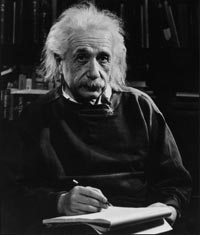 The number of letters Darwin sent (black) and received (red), and the number of letters that Einstein sent (green) and received (blue).In the last 30 years of his life, Einstein wrote a letter every day.(Nature)
The number of letters Darwin sent (black) and received (red), and the number of letters that Einstein sent (green) and received (blue).In the last 30 years of his life, Einstein wrote a letter every day.(Nature)Einstein manages mail like your way
 If you're like Einstein - a genius physicist - you'll immediately respond to some incoming mail, and let some people wait. Of course, some mail you will never answer.
If you're like Einstein - a genius physicist - you'll immediately respond to some incoming mail, and let some people wait. Of course, some mail you will never answer.
And at any time, you'll find an old letter in your inbox and answer it.
A new study finds Albert Einstein's mail handling, as well as that of Charles Darwin, following a pattern similar to modern email communication.
Einstein sent more than 14,500 letters. But he received more than 16,200, and answered only 1/4 of them. Darwin sent more than 7,500 letters, but answered only 32% of the nearly 6,530 he received.
Of course, writing letters takes longer than email, but the mathematical correlation between quick and slow responses is similar, João Gama Oliveira from Aveiro University in Portugal said.
 The number of letters Darwin sent (black) and received (red), and the number of letters that Einstein sent (green) and received (blue).In the last 30 years of his life, Einstein wrote a letter every day.(Nature)
The number of letters Darwin sent (black) and received (red), and the number of letters that Einstein sent (green) and received (blue).In the last 30 years of his life, Einstein wrote a letter every day.(Nature)Among Einstein's replies, 53% were sent in 10 days. For Darwin, this number is 63%. But sometimes they also postpone this until months later. Einstein began a reply by explaining that he had just discovered that the letter had come more than a year ago, while screening a mountain of letters .
"In the correspondence of both Darwin, Einstein and email today, we find that most are answered in a short time, but sometimes over a very long period of time," Oliveira said. "In other words, with both email and letter, the response time stretches across a very wide area, and there is no typical value that we can say that the response time is around that point." .
Analysis also shows that Darwin, who came up with the idea of natural purification in evolution, and Einstein - the father of modern physics - must have prioritized hand letters. "Their timely response to most letters shows that they are both aware of the importance of intellectual transactions," Oliveira and colleagues wrote.
T. An ( according to LiveScience )
- Handwritten version 95 years revealed the secret of genius Albert Einstein
- The new finding contrasts with Einstein's brain
- Unknown things about Einstein
- The son carries the 'bad gene' of genius Albert Einstein
- What scientists did with Albert Einstein's brain
- About 5,000 Einstein documents were posted online
- Two women in Albert Einstein's life
- The secret of Albert Einstein's stormy affairs
- 9 'secrets' about Albert Einstein
- Letter auction on Einstein's God
- Einstein's letter cost $ 14,000
- The secret of the connection between Albert Einstein's theory and the devil
 The most famous scientific failures in history
The most famous scientific failures in history Mysterious genius mechanic and the machine froze time
Mysterious genius mechanic and the machine froze time The son carries the 'bad gene' of genius Albert Einstein
The son carries the 'bad gene' of genius Albert Einstein Isaac Newton
Isaac Newton